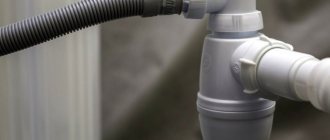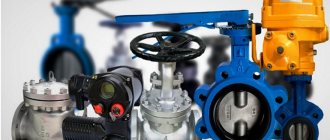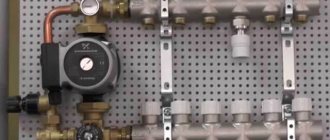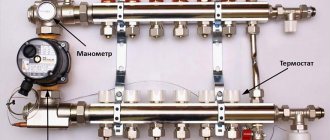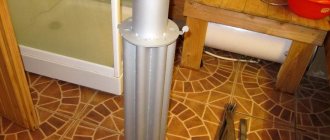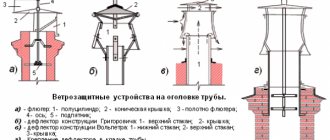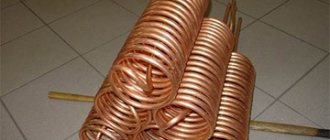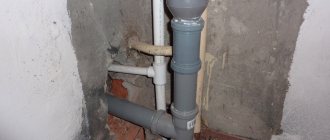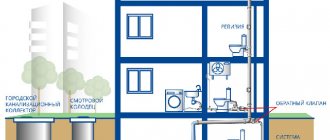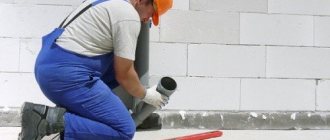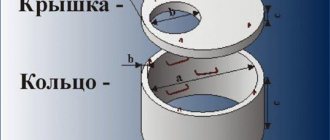The ventilation outlet of the sewer system is designed to allow air to enter the vacuum zone that forms each time water is drained, eliminating unpleasant odors and noise. An air valve for sewerage can replace a classic device, a drain pipe, and does not have the typical inconveniences associated with the operation of the latter, including icing and narrowing of the outlet going to the open air during the cold season, as well as the likelihood of unpleasant odors getting into the open house windows.
Design and principle of operation of the air valve
An air sewer valve is a body whose diameter corresponds to a similar pipe parameter (hence, the flow parameters in it are identical), equipped with a rod or membrane that closes the outward-facing inlet.
At rest, the pressure existing in the pipeline keeps the rod or membrane in the closed position, “pressing” them from the inside. While the flow rate increases when water is drained, a vacuum is formed in the pipeline, the valve or membrane opens, letting in the amount of air necessary to equalize the pressure. When the parameter is normalized, the closing device returns to its original position.
Important feature: The return flow of air with an unpleasant odor from the sewer system into the living space is eliminated due to the pressure difference during the period when the hole is open. Air cannot move from a low pressure zone to a high pressure zone.
Operating principle of a vacuum sewer valve
There are also combined models that work both for air intake and air outlet.
The installation location of such devices needs to be carefully considered; it is not always advisable to place them in a bathroom or toilet; it is possible to move them outside of residential premises or install them in a special unit.
Valve installation recommendations
When installing, it is important to follow the rules that will help maximize the efficiency of the sewer valve:
- Installation is only permissible in a heated room. This will help avoid valve failure due to low temperatures.
Installed device under the bathroom Source homemasters.ru
Types of air valves
It was already mentioned above that the design of non-return air valves for sewerage can have a membrane or a rod. Such models work almost equally efficiently, however, plastic membranes are more susceptible to wear and need to be changed periodically.
- Some types of devices can only be installed on one drainage point (sink, toilet, etc.). These automatic devices have a low throughput.
- The 110 mm sewer air valve can be mounted on a common riser, thus providing ventilation for several sewer pipes at the same time.
- Combined models are universal and have the advantages of products of both the first and second categories.
The photo shows an aerator for sewerage.
It is obvious that local (designed for one pipe) models have a smaller diameter than those capable of providing ventilation for the entire system. In most cases, DN 50 mm models are used for these purposes.
According to the installation method, the valve (sewer aerator) can be:
- threaded,
- flanged,
- coupling
Fan valve for sewerage 110 and 50 mm
There are many different types of devices. The most popular are 50 and 110 mm fan valves. They are suitable for equipping most sewer systems. Before installing the device, you need to familiarize yourself with its characteristics and operating principle. The structure of the part is quite simple. The device has several components.
It consists of:
- Lids. The part is needed to protect against dirt.
- Rubber gasket. The element makes the movement of the rod smooth and limits it.
- Stock The component is needed to control the difference in pressure indicators inside the line.
- Technical hole. Its task is to pass air inside the device.
- Product housings.
The operating principle of the part is quite simple. During draining, a pressure difference appears inside the line. This causes noise. The valve reacts to this and opens the lid, allowing air to pass through. This helps stabilize the pressure indicator. Next, the lid of the device is closed. This prevents unwanted odors from appearing in the building.
The most modern solution is the Ottima sewer check valve - thanks to a system of two dampers and protection from rodents https://agpipe.ru/kanalizacionnye-truby-pvh/obratniy_klapan_dlya_kanalizacii
Installing the part allows you to solve several problems.
This part is indispensable if:
- There is no way to install a ventilation duct through the roof.
- During the construction of the building, a vent channel used to ventilate the sewerage system was not constructed.
The part in question is mainly used in private two- or one-story houses.
Sometimes the part is placed on the first two floors of multi-apartment buildings to provide a decent level of protection.
The selection of parts depends on the cross-sectional size of the channels. Two standard versions of the fan valve are available: 50 and 110 millimeters. Devices with a larger cross-section are mounted on risers, and smaller ones on branches from them. The 50 mm device can be installed on risers from a maximum of two plumbing devices.
Each model has its own characteristics.
The valve may have in its design:
- rubber membrane;
- stock.
Both components implement the same function. Note that parts equipped with a rod are more durable. The price of valves can be from 2 to 20 US dollars. The cost is affected by the quality of the part and the manufacturer. Before you buy a device, test it for serviceability.
Equipment installation
An air valve for unvented sewer risers is not the only option for installing equipment. The valves can duplicate the classic ventilation scheme and be installed instead of or together with vent structures.
The main requirement when choosing an installation location is to maintain the ambient temperature above 0° C. This will avoid freezing and disruption of the equipment.
at which the air valve for sewage is installed is of great importance
- If there is no drain for draining water in the floor, the valve is placed 10 cm higher than the location of the highest outlet of the plumbing fixture or water-consuming equipment.
- If there is a ladder, the valve is placed 35 cm above the floor level.
Important: Maintaining such distances protects the fan valve from contamination.
It is necessary to select the installation location in such a way that it can be easily accessed for inspection and repair. If a vacuum valve for a sewer with a diameter of 110 mm is supposed to be covered with panels, plasterboard or other structures, it is necessary to provide such structures with special doors or hatches to avoid the need for complete dismantling during repair work.
Installation options for sewer aerators
The free end of the pipe or its socket is chosen as the installation location.
In some cases, it is advisable to install an air sewer valve in the attic or in a specially designated household room.
After selecting the installation location and purchasing a product that fully complies with the requirements and is suitable in terms of geometric parameters (diameter), the valve is installed in accordance with its design (on a thread, in a flange, using a coupling). It is important to ensure the tightness of the joints and check this parameter after completion of installation work.
There is no need to confuse the air and non-return valve for sewerage. We have a separate article about the latter on our portal.
If you are interested in finding out what a sewer pipe is used for in a private house, then we also talked about this in another article.
And you will find the features of independent construction of a peat toilet on the site here https://okanalizacii.ru/postrojki/tualet/torfyanoj-tualet-dlya-dachi-svoimi-rukami.html
Signs of problems with the sewer system
Irregularities in the sewer system can be identified by characteristic signs.
These are:
- presence of extraneous sounds;
- spread of unpleasant odors.
In houses with a long-established sewer network, it is necessary to first check all elements of the network for damage. Deviations in the operation of the new system may indicate that it was installed incorrectly.
If during the inspection it was possible to exclude such causes of possible damage as cracks in pipelines, blockages in drain pipes or ventilation ducts, or improper slope of pipes, then the cause of the problems is most likely insufficient air flow. In this case, installing a vacuum valve will help troubleshoot the system.
There can be several reasons for improper operation of the sewer system: blockage in the pipes, violations of installation rules, blocking of the ventilation (fan riser) by residents on the upper floors. Sometimes the source of trouble can only be identified by a specialist
Features of operation
Rules regarding the selection and installation of air valves in the sewer systems of apartments and private houses were included in SNiP only about 10 years ago. The decision on the mandatory installation of such a device is made by a specialist, however, it is believed that the use of an aerator cannot reduce the efficiency and quality of the system. In general, this statement is true, but it is important to monitor the condition of the equipment and its serviceability.
Disturbances may include sticking of the membrane or rod in a certain position.
- If the stop occurs in the “open” position, there is a risk of unpleasant odors from the sewer entering the room.
- If the valve gets stuck in the closed position, the water seals may rupture.
At the same time, the simplicity of the design and the associated high reliability and durability of the equipment, combined with timely inspections of the valves, will make it possible to avoid emergency situations.
Sewage air valve 110 mm installed on riser
Installing aerators together with traditional ventilation outlets or vent devices virtually eliminates the possibility of a critical change in pressure in the system and failure of water seals.
Sometimes a situation arises when an air valve that has worked effectively for several years ceases to “cope with its responsibilities,” although there are no breakdowns or malfunctions. Most often this is due to changes in the operation of the sewer system itself, for example, with the installation of a washing machine that discharges water under pressure. At high flow rates, the pressure in the pipeline changes more sharply, so it is better to install an additional individual valve on the new unit.
How to choose the right device?
In addition to focusing on the horizontal and vertical arrangement of the sewage system, nominal pressure, installation dimensions and method of fastening, when choosing an aerator, a number of other nuances must be taken into account.
When purchasing a vacuum valve for a sewage system, you should be guided by the following criteria:
- standard size - the diameter of the device, which must coincide with the cross-section of the pipe;
- installation method - open or closed;
- the presence of a membrane or rod in the locking mechanism;
- connection method – horizontal/vertical;
- the presence of a heat-insulating wall of the riser;
- nominal pressure limits for a specific device;
- the material from which the aerator is made - it must be the same type as the pipeline.
All elements of the device must be made of durable materials that can withstand the aggressive environment of the sewer system and other destructive factors.
It is important that in the event of a mechanism failure, it is possible to adjust its operation manually.
The price of fan valves varies depending on the diameter, brand and type of device. An aerator with a diameter of 50 mm will cost from 45 to 200 rubles, and with a cross-section of 110 mm - from 120 to 1,250 rubles.
Only a reliable valve, which is the basis of the entire structure, can provide adequate protection against unpleasant odors and backflow of contaminated water. Since aerators can serve as an excellent passage for rodents from sewers into living spaces, properly designed models provide protection for this case.
The practical side of the issue
People choose an air valve for sewer ventilation for several reasons. This is, first of all, a reasonable price, high reliability and simple installation instructions. Any normal owner can easily install this device on their own.
A few words about prices
As I already said, the cost of branded aerators is quite affordable, especially considering that, in fact, such a valve is installed once and for the rest of its life. The maximum that may have to be done is to change the seal periodically, on average once every 10–15 years.
Different types of aerators.
| Manufacturer | Diameter | Price |
| Domestic valve | 50 mm | 128 rub. |
| Domestic valve | 110 mm | 335 RUR |
| Mini-Vent | 32 mm – 52 mm | 1580 RUR |
| Maxi-Vent | 75 mm – 110 mm | 2340 rub. |
| Mcalpine | 50 mm | 318 RUR |
| Mcalpine | 110 mm | 618 RUR |
Installation Requirements
- Let's start with the fact that such devices are installed exclusively in heated rooms , it is not necessary that it be residential, the main thing is that the temperature does not drop below zero;
- If you install an aerator in an apartment on a separate branch, then it must be at least 100 mm above the main horizontal pipe . But if the room has a drain built into the floor, then the valve is installed 350 mm higher from the floor level;
Aerator with external threaded fixation on the pipe.
- On a separate horizontal branch in the apartment, a sewer ventilation valve is placed behind the outermost plumbing fixture (counting from the central riser);
- The distance from the nearest water seal to the valve starts from 200 mm.
Siphon with aerator.
The installation itself often does not cause difficulties. Any factory valve has instructions. But even if for some reason it was not there, all such devices are mounted in two ways.
If there is a thread, then they simply screw in. If there is no thread, which happens more often, then the aerator fits into a silicone socket of a suitable diameter.
Valve with seal for installation in socket.
Homemade aerator
No matter how much a factory aerator costs, our man will, in any case, try to assemble it with his own hands. To tell the truth, making such a valve for an ordinary two-story cottage or city apartment will not be difficult.
- The basis of such an aerator is a plug for a sewer pipe of the desired diameter;
- The mechanism itself consists of a spring from a standard ballpoint pen, a self-tapping screw that can move freely inside this spring, 45 mm long, a plastic membrane and a foam seal;
- First, we cut out a round plastic membrane and make a hole in the center with the diameter of the self-tapping screw. For these purposes I used the bottom of an old paint bucket;
- As a seal, you can take foil penofol (foamed polyethylene covered with foil) or simple foam rubber. The diameter of the sealing circle is made 10 mm wider than the plastic membrane. Just like in the membrane, a hole for a self-tapping screw is cut in the center of the seal;
- Now we take our plastic plug for the pipe and poke a hole in the center with an awl. Then we drill another 3–4 holes with a diameter of about 5 mm, at a distance of 20–30 mm from the center. After drilling from the inside, do not forget to chamfer the edges so that nothing unnecessary sticks out;
- The seal will need to be glued to the plastic membrane;
- Now it's time to assemble our aerator. We put the spring on the self-tapping screw. Behind it, we put on a membrane with a glued seal and lightly screw the self-tapping screw into the hole pierced with an awl from the inside of the plug. That's basically it, the homemade aerator is ready, all that remains is to lubricate the edges with silicone and place it on the pipe.
Homemade aerator.
Before installing a homemade valve, it should be adjusted. Here you just need to blow into each hole; if the air comes out with force, then use a self-tapping screw to loosen the spring pressure. Then try to draw air into yourself; if the membrane is permeable, then you need to tighten the self-tapping screw slightly.
You can do it even simpler. At the end of the apartment drain branch we install a plugged oblique outlet for the valve. We drill a hole with a diameter of 10 mm at the bottom of the outlet pipe, next to the plug.
After this, we cut out a membrane with a diameter of 40x60 mm from smooth rubber, place it on the inside of the hole and fix it to the bolt, as shown in the diagram. Then close the plug.
It will last you about 5 years, then the rubber will have to be changed, as over time it loses its elasticity and becomes deformed.
Diagram of a homemade ventilation valve for sewerage.
Reviews
Vacuum valves have proven themselves well among consumers. The advantage of these devices is their versatility and ease of use. Vacuum valves from companies such as Ostendorf and McAlpine deserve special attention.
The cost of products of these brands varies from eight to twenty US dollars. This is quite expensive equipment. But it has excellent performance characteristics and durability. Reviews of devices from these manufacturers are very good. But for equipping large buildings it is better to use a fan riser.
